Yamaha is a formidable name in classical guitars. It is a trusted brand over decades, especially in the beginner and intermediate categories. There are four broad classes of Yamaha classical guitars:
- School Series for beginners – CGS102A, CGS103A, CGS104A
- C Series for beginners – C40II, CS40II
- CG Series for early to advanced beginners and intermediate players – CG102, CG122MCH/CG122MSH, CG142CH/CG142SH, CG162C/CG162S, CG182C/CG182S, CG192C/CG192S
- CG Series of hand crafted guitars – GC12C/GC12S, GC22C/GC22S, GC32C/GC32S, GC42C/GC42S, GC82C/GC82S
Yamaha also have a Flamenco version with their CG172C/CG172S model. And a line of electric-cum-classical guitars in their NTX and NCX Series.
Yamaha makes some of the best instruments in every class. We cover only the classical models and compare their feature sets. No flamenco or electric hybrids or the really top end concert variants. As you read about the various Yamaha models, do keep two things in mind for this to be useful to you.
1. Check the current price of the guitar model. A model’s price gives you a fair indication of where the guitar ‘belongs’ in the competitive market scene. These are roughly the price clusters: Below $250 is the true beginner range. Above this but below $1200 is the intermediate range. Anything higher than $2,000 is the expert range.
2. Your own stage of development. Are you a beginner to the guitar itself or only to the classical guitar? Are you taking formal lessons? Do you need to get back to your ‘missed vocation’ of an earlier era and invest some serious time and money to renew a lost skill? Are you exploring nylon sounds as something to add color to your acoustic creations? Only you know your skill level and your intentions.
Given their sheer range of guitars, Yamaha is very likely to have the right model for you. Their quality and build are near legendary. (I’m not associated with them in any way. I just happen to be familiar with their product lines for decades.) Their model range spans every price point: from the popular and affordable C40 to the Grand Concert GC series.
Table of Contents
School Series
- CGS102A
- CGS103A
- CGS104A
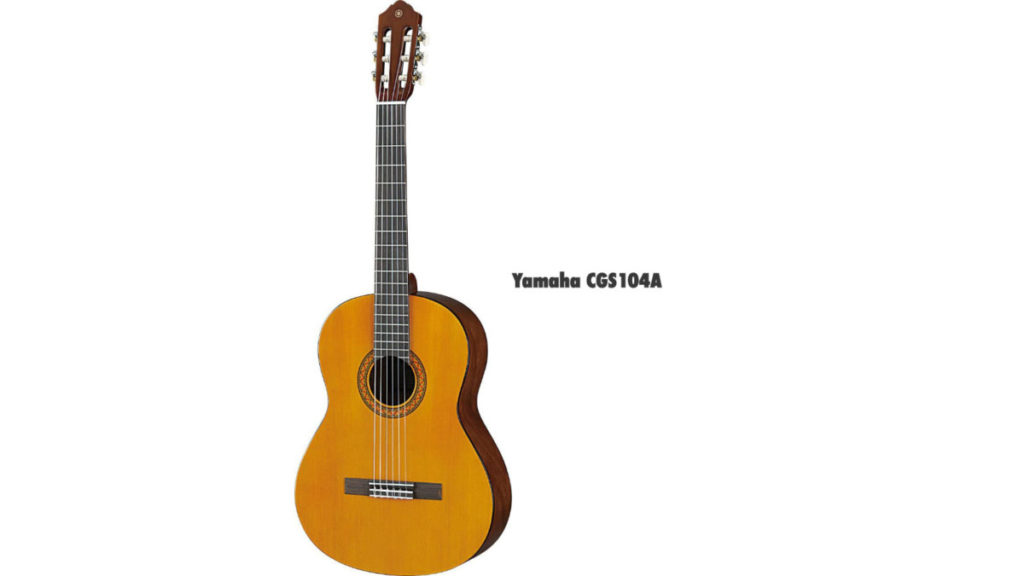
These are guitars for beginners including small children as young as 6 years old. While the CGS104A is a full sized guitar, the other two are smaller. Yamaha calls its CGS103A a three-fourths guitar and its CGS102A a half-size guitar. These terms are by no means standard in the industry. They are meant for younger players or adults with small hands.
Scale length is a useful measure that cuts across brands. It is the distance from the bridge behind the sound hole to the vertical ‘nut’ where the strings enter the headstock or winding mechanism. A standard size classical guitar has a scale length of 650 mm (25 9/16”).
The CGS103A has a reduced scale length of 580 mm (22 13/16”). It is for the older child or an adult with small hands.
The CGS102A has a scale length even shorter at 535 mm (21 1/16”). It is for a child of 7 years or younger. Both the smaller variants have lesser nut width of 48 mm (1 7/8”) instead of a full size 52 mm. This helps in the easy placement of left hand fingers.
Barring the length and the nut width, all 3 models are essentially the same in every other way.
| Feature | Details |
| Top wood | Spruce |
| Other woods | Various local tone woods based on availability for back, sides and neck. Rosewood for bridge and fingerboard |
| Number of frets | 19 |
| Finish | Gloss |
| Notes | All 3 guitars are good choices for a beginner. A widely accepted opinion is that a young learner below 7 years of age will do well with a ‘half-size’ guitar. As many a grandfather who has gifted the CGS102A to a young one will attest, a smaller guitar makes learning easy and enjoyable. The guitar still has all the 19 frets, except they are closer to one another and easier to play. Adults with small hands (as also older children up to the age of 12 years) may find the three-fourths’ size CGS103A a good option. The price is affordable and the build is Yamaha |
| Affiliate Links | Check the price of Yamaha CGS102A at Sweetwater | or at Amazon Check the price of Yamaha CGS103A at Sweetwater | or at Amazon Check the price of Yamaha CGS104A at Amazon |
C Series
- C40II
- CS40II
The C40 (today’s version is C40II) is probably the best known beginner’s classical guitar. It is full size, ‘built like a tank’ and it has a good warm sound. If you’re moving from a 3/4 size guitar or just moving into classical guitars for the first time, this is seriously worth your while. It is affordable.
Want to hear some exquisite Bach on the beginner’s guitar? Check this out.
| Feature | Details |
| Top wood | Spruce |
| Other woods | Although you’re likely see woods like Meranti and Nato mentioned, Yamaha says it uses various local tone woods based on availability for back, sides and neck. Rosewood for bridge and fingerboard |
| Number of frets | 19 |
| Finish | Gloss |
| Notes | Frankly, going by past experience of hundreds of guitarists all over the world, the C40II comes with an undisputed heritage of performance. If you want to delve deeper into this popular Yamaha variant, check out my full review of the C40. Whether you are a student yourself or you are considering a gift to a young one with talent, you can learn what makes this legend tick |
| Affiliate Links | Check the price of Yamaha C40II at Sweetwater | or at Amazon |
There is an interesting variant to the C40 which is the CS40 (don’t miss the ’S’ presumably for ‘small’). This is the very same guitar otherwise but its scale length is what Yamaha terms three-fourths. Or, 580 mm instead of the full 650 mm. This will help adults with small hands or older children who’d like to lay their hands on the famed C40 guitar.
(An added note is that of late – June 2020 – this model isn’t available with many online vendors although Yamaha lists this as one of its current models.)
CG Series
- CG102
- CG122MCH/CG122MSH
- CG142CH/CG142SH
- CG162C/CG162S
- CG182C/CG182S
- CG192C/CG192S
The CG Series is the next step up from Yamaha, directed at advanced beginners and intermediate guitarists. There are a few levels of guitar to choose from – depending on the materials used, the crafting and your own sound and design needs. Generally, these guitars are better made with improved volume and response than beginner guitar models.
You really don’t have to worry about the build and lasting quality of a Yamaha, so it’s down to what kind of sound expectations you have in mind.
Almost every model comes with a cedar or spruce (top wood) variant. The top wood is considered the most important part of the guitar for it has a direct influence on the sound. Cedar is known to have a warm, sweet sound. Spruce has a strong treble and sparkle. Which you find attractive is entirely a subjective matter.
CG102
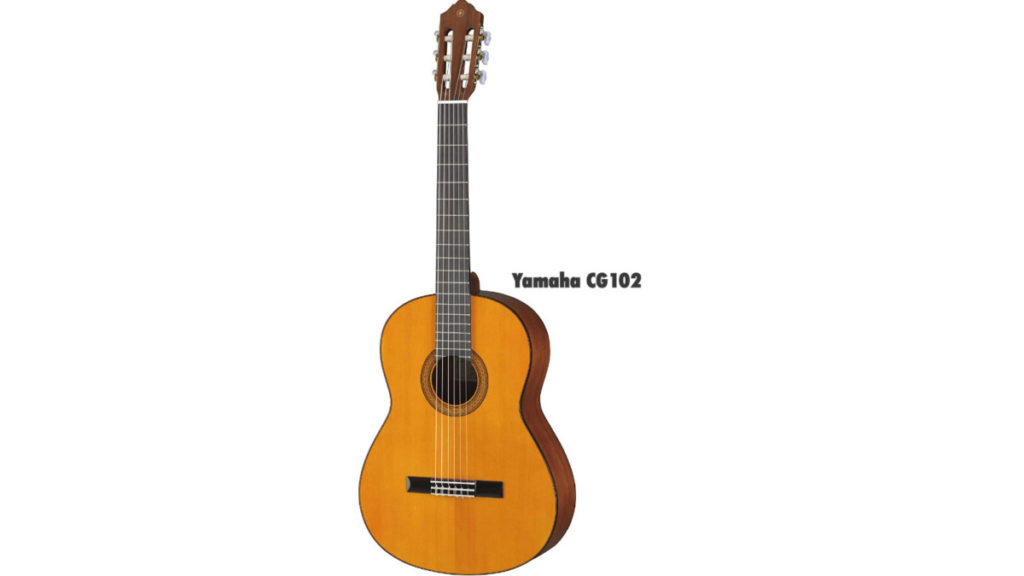
| Feature | Details |
| Top wood | Spruce |
| Other woods | Back and sides are of Nato. Various locally sourced tone woods may be used for the neck depending on availability. Rosewood for bridge and fingerboard |
| Number of frets | 19 |
| Finish | Gloss |
| Notes | This is a reasonably priced classical guitar with a rich tone that beginners will enjoy. It seems to be a favorite with those coming over from a regular acoustic and wishing to check out the classical cousin. Its full sound and comfortable hold are attractive as an excellent first classical guitar. Its robust construction makes it a good choice. With the generous spacing between the strings (compared to the acoustic guitar) picking up tips from YouTube tutorials and playing them becomes easier |
| Affiliate Links | CG102 – Check the price at Amazon | Guitar Center |
The CG102 model is a full size guitar of 650 mm (25 9/16”) scale length and a full nut width of 52 mm (2 1/16”). The model is not to be confused with the half-size model of Yamaha’s – the CGS102A (see above.)
CG122MCH/CG122MSH
If you’ve played a beginner level guitar like the C40 or the CG102 (or any non-Yamaha equivalent), you can feel the quality upgrade in sound and playability. The CG122M – whether cedar top or spruce top – gets you into the world of solid tops as against laminated tops which are the mark of a beginner guitar.
Laminated simply means thin slices of wood pasted together. In terms of sound quality and volume, this is inferior to using a single piece of solid wood which resonates evenly and big. I highly recommend my article Solid Wood vs Laminates to help you understand the differences.

| Feature | Details |
| Top wood | Solid American Red Cedar Top (CG122MCH) Solid Engelmann Spruce Top (CG122MSH) |
| Other woods | Nato back, sides and neck. Rosewood for fingerboard and bridge |
| Number of frets | 19 |
| Finish | Natural matte finish |
| Notes | An upgrade into a better class of guitar for the novice student. To a practicing guitarist from other styles, this one has much to offer by way of playability. It comes with Savarez D’Angelico Light Tension strings. The rosette decal is cool |
| Affiliate Links | Check the price of Yamaha CG122MCH at Amazon Check the price of Yamaha CG122MCH at Sweetwater |
CG142CH/CG142SH
The spruce version features the solid Engelman spruce for a bright sound with good projection. The harmonics are better and the tonal balance between the treble strings and bass strings are evident than in a purely beginner’s guitar.
Here’s a good demo of what the CG142S sounds like. The discussion is in Russian (I think) but the guitar sounds great.
The CG142 is aimed at the beginner, perhaps the ambitious beginner who wants a bit more. It is a full-size guitar with a full nut width of 2”.
| Feature | Details |
| Top wood | Solid American Red Cedar Top (CG142CH) Solid Engelmann Spruce Top (CG142SH) |
| Other woods | Nato back, sides and neck. Rosewood for fingerboard and bridge |
| Number of frets | 19 |
| Finish | Gloss |
| Notes | A full-size affordable classical guitar that is value for money. For someone stepping up from a 3/4 model or entering the classical world for the first time from the acoustic side, this is a good quality introduction to a solid top. I know of a guitar teacher who recommends the CG142 to his early stage students instead of going for a cheaper ’student’ guitar. Obviously this is meant for those who wish to take the classical guitar seriously as a hobby or otherwise. The guitar should serve them years. |
| Affiliate Links | Check the price of Yamaha CG142CH at Amazon Check the price of Yamaha CG142CH at Sweetwater |
CG162C/CG162S
The CG162 is ‘built with strength and design at a price that anybody can afford’. There are solid woods at play here, no laminates. And there is emphasis on a strong mid-range sound that is balanced. The Ovangol wood, an interesting choice, for the back and sides is said to add a lively sparkle. This guitar is earning high praise for its playability and response from users online.
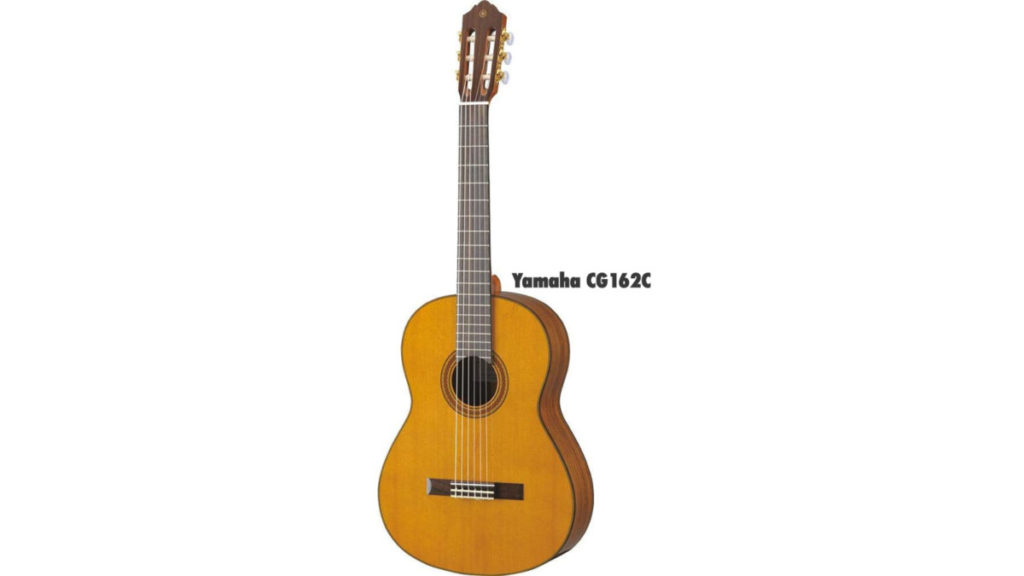
| Feature | Details |
| Top wood | Solid American Red Cedar Top (CG162C) Solid Engelmann Spruce Top (CG162S) |
| Other woods | Ovangol for back and sides, Nato for neck, Rosewood for fingerboard and bridge |
| Number of frets | 19 |
| Finish | Gloss |
| Notes | After trying many guitars in the sub-$500 range, it is possible you will be impressed with the CG162. Many have been. One user went so far as to say it was better than even guitars in a higher price bracket: like Yamaha’s own flagship CG192. While opinions can be pretty subjective, there is no denying that there is a sizable lot of owners out there who truly believe they’ve lucked into something very valuable for their money with the CG162. For an early guitarist knocking on the doors of intermediate playing, a good guitar can bolster confidence. This is a solid option to consider. |
| Affiliate Links | CG162C – Check the price at Amazon | Guitar Center CG162S – Check the price at Guitar Center |
CG182C/CG182S
There are purists when it comes to expensive classical guitars who believe that a proper fingerboard should be nothing other than ebony. Not rosewood painted black, but real ebony. The CG182, even though it cannot be considered an expensive guitar, introduces the student to an ebony fingerboard. Other wood choices are Rosewood back and sides, a feature of more expensive guitars.
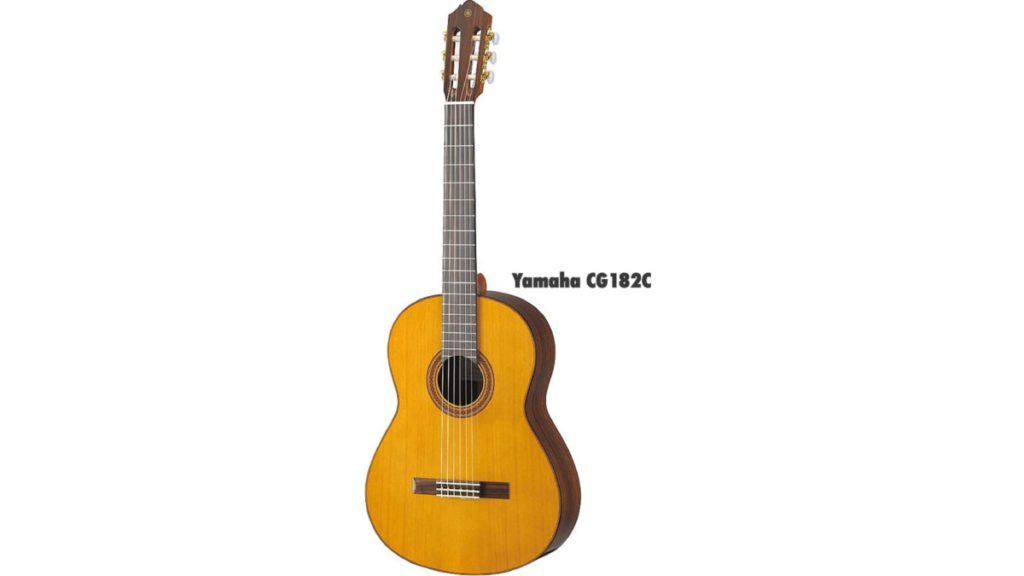
| Feature | Details |
| Top wood | Solid American Red Cedar Top (CG182C) Solid Engelmann Spruce Top (CG182S) |
| Other woods | Rosewood for back and sides. Nato for neck. Ebony for fingerboard |
| Number of frets | 19 |
| Finish | Gloss |
| Notes | The CG182 is spoken of highly for its volume and projection. Its mosaic-design rosette, gloss finish, gold hardware and mother-of-pearl peg tuners lend it a quiet and classy exterior. The neck was deliberately made thin and lighter to increase playability. It is a guitar built for a small room performance for the budding guitarist who is gaining confidence in his repertoire. |
| Affiliate Links | CG182C – Check the price at Amazon | Guitar Center CG182S – Check the price at Amazon | Guitar Center |
CG192C/CG192S
For guitarists well on their way to becoming an intermediate player with a confident repertoire, this is Yamaha’s top of the line offering at the intermediate range. Beyond the CG192 we get into the company’s highest range: the Grand Concert (GC) Series. It is up to us to make that visual distinction between the intermediate CG range and the high-end GC range and remember which is which!
Here’s a Baroque composition for the classical guitar by S.L.Weiss played on the CG192C.
| Feature | Details |
| Top wood | Solid American Red Cedar Top (CG192C) Solid Engelmann Spruce Top (CG192S) |
| Other woods | Rosewood for back and sides. Mahogany for neck. Ebony for fingerboard |
| Number of frets | 19 |
| Finish | Gloss |
| Notes | It is possible, as some have done, to jump straight from a beginner C40 onto the CG192 (or a Cordoba C7 or equivalent) by skipping all the in-between line of guitars. It is a massive jump in tonal quality, playability, touch, durability – and the price, of course. Between the 182 and 192, is there a significant difference? The mahogany wood for the neck as a significant upgrade? No, not really. Along with better tuners, better wood may count for longevity of the guitar, but the impact on sound quality? Negligible. However, you may consider the price difference – not too much really – and opt for the older brother, perhaps. |
| Affiliate Links | CG192C – Check the price at Amazon | Guitar Center CG192S – Check the price at Amazon | Guitar Center |
GC Series
- GC12C/GC12S
- GC22C/GC22S
- GC32C/GC32S
- GC42C/GC42S
- GC82C/GC82S
Yamaha has decades of experience in making hand crafted guitars with their senior craftsmen having formally trained in traditional Spanish methods. The woods are hand chosen, the features are far more refined. Welcome to the Grand Concert Series (GC).
Here’s a video from Yamaha about their handmade guitars. I know it’s a sales video, but I’m a sucker for watching the guitar-making process somewhat spellbound. I have spent a whole afternoon outside Valencia in a luthier’s factory watching stuff happen. The luthier’s craft is fascinating.
We’ll cover a couple of models here for they are still within an intermediate guitarist’s grasp in terms of affordability. The coveted CG82 may not be reachable for all. Not even the GC42 perhaps. But a couple of models in the range – GC12 and GC22 – are worth investigating.
GC12C/GC12S
We are entering the world of carefully chosen tone woods, all solid with an ebony fingerboard. The GC12 is a popular model with classical guitarists and those wanting to add some quality nylon sounds to their soundscapes.
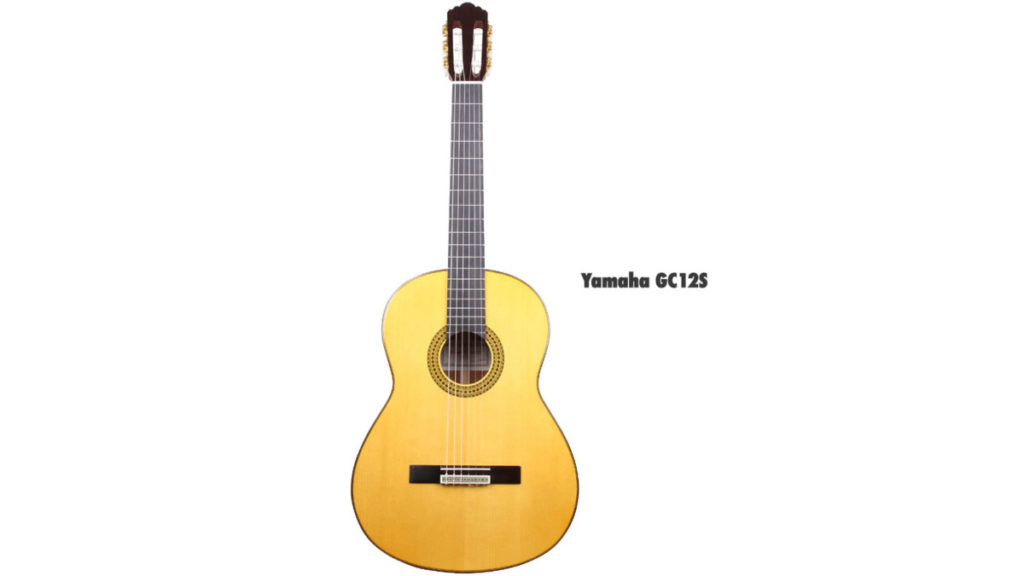
| Feature | Details |
| Top wood | Solid European Spruce (GC12S) American Red Cedar (GC12C) |
| Other woods | Solid Mahogany for back and sides. Ebony fingerboard |
| Number of frets | 19 |
| Finish | Gloss |
| Notes | The GC12 is known for its bright sound. You expect the sound to mature with age as with guitars of this caliber. Guitars at this price range have a bone saddle, but the GC12 has one made of Urea. The word doesn’t sound too good to my ears but I’ve learned it is indeed a very good material for the job. (If it bothers you still, you can replace it with a bone saddle.) The choice of high-quality tone woods lends subtlety to the sound. The ebony fretboard has a good touch. Great tuners. This is certainly the next level of guitar for an intermediate guitarist. |
| Affiliate Links | Check the price of Yamaha GC12S at Sweetwater | or at Amazon Check the price of Yamaha GC12C at Sweetwater | or at Amazon |
GC22C/GC22S
The GC22 has solid Rosewood for its back and sides and the top is either solid American Red Cedar or solid European Spruce. It is a tone wood combination, typical of higher quality guitars, that promise nuanced sound and expression. As the woods age, the tonal richness improves.
Listen to some fine playing of classical music on the GC22C (along with some surprising Bossanova rhythms down the line).
| Feature | Details |
| Top wood | Solid European Spruce (GC22S) American Red Cedar (GC22C) |
| Other woods | Solid Rosewood for back and sides. African Mahogany for neck. Ebony fingerboard |
| Number of frets | 19 |
| Finish | Gloss |
| Notes | Consistent quality is Yamaha’s strong point. You can expect a GC22 to sound big and sustained. Trebles are not overpowered by the bass. And the sound will certainly improve with age. In general terms, it can be compared to a Cordoba C10. I’d pick the Yamaha, no hesitation. The neck profile is very comfortable for better playability. Even owners of the excellent CGS192 will find the GC22 a step up the ladder. |
| Affiliate Links | Check the price of Yamaha GC22C at Sweetwater Check the price of Yamaha GC22S at Sweetwater | or at Amazon |
If you want to make an informed decision by evaluating many brands of classical guitar, not just Yamaha, I recommend our detailed review of classical guitars at many price points. If you want to know more about Yamaha’s worthy competitor and a popular brand in its own right Cordoba, read my article Yamaha vs Cordoba for a comparison of various models from both.
_______
Happy decision making!

I have a CGS-104. I am wondering what is the difference between a 104 and a 104A Yamaha.
Also, do they benefit from a bone replacement saddle and nut?
Thank
You and all the best!!!
To the best of my knowledge it seems to be the same model basically but a newer version. Remember writing to them once and never got a reply. At this price level, the bone nut/saddle doesn’t seem to make a difference.
Hi great article.
I have similar question.
I have a CG-40A and wonder what the A stands for?
Thanks
Westy
Same answer as above. In fact, you don’t get the CG40 any more online. I can only guess they have ‘upgraded’ the same model by adding the ‘A’.